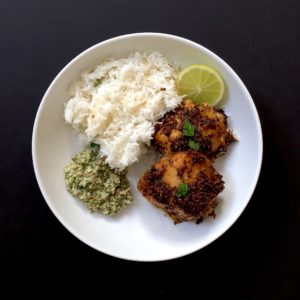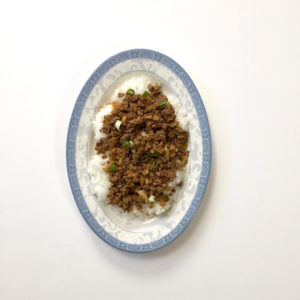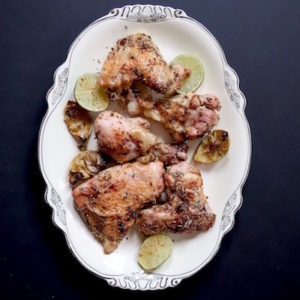Chicken with Red Pepper Sauce
About a week ago I was rereading Diana Henry’s The Gastropub Cookbook and landed on Chef Peter Robinson’s recipe for Squid with Piri Piri Sauce.

I page through my cookbooks a lot. Do other people? I hope so. It’s amazing how often you find something you missed the first time around, or didn’t understand, or weren’t ready for. And now here it is, smiling up at you.

Why was I sitting and not cooking? Well, my sciatic nerve, it decided to say hi.
This is not pictured.

So there I sat, not exactly Miss Muffett, nary a curd nor whey in sight, cooking butt and brains with heating pads and steroids.

This was not anyone’s idea of a good time, but then again, many out there are having a far worse time of it. While I was busy feeling sorry for myself, Notre Dame caught fire, a loss no matter one’s beliefs. Then there was Easter Sunday in Sri Lanka. As I write, Mozambique, still reeling from Cyclone Idai, is being hit by Cyclone Kenneth.
Yours truly hobbled into the kitchen and started cooking.

—
Like most of my recipes, Chicken with Red Pepper Sauce is forgiving and flexible. If you must use boneless, skinless breast, so be it. Bone-in, skin-on thighs will taste better; wings are heavenly. Best of all, though, were “drummettes:” searingly hot, with the ideal ratio of bone to meat. That “drummettes” do not exist in nature does give pause; I bought them by mistake. Delicious nevertheless.

I have not attempted this, but small broiler chickens, quail, or poussins doused with pepper sauce would be a thing of beauty.

Whatever cut you decide on, chicken with red pepper sauce is messy food, not to be eaten with people who fret over fork placement. Nor is this the time to wear your new white shirt.

Leftover chicken with red pepper sauce hold beautifully. It’s especially good rolled into tortillas with crisp lettuce, fresh cilantro, mild onion, and Sriracha sauce. If you can locate decent tomatoes, go for it.

Chicken with Red Pepper Sauce
Adapted from Chef Peter Robinson’s Squid Piri Piri recipe, which appears in Diana Henry’s The Gastropub Cookbook.
Peter Robinson is now Chef at Bibendum and Chef/Owner at The Old Butchers.
Serves 2; easily scaled upward
Cooking time: the chicken benefits from marinating 4 to 24 hours, but you can make the dish without marinating it.
Please read notes, bottom, for a discussion of ingredients, amounts, and methods before beginning to cook. See bottom of ingredient list for discussion of extra pepper sauce to serve at table.
2-4 large skin-on, bone-in chicken thighs
1 large, sweet red pepper (mine was 7.6 ounces/215g)
1 fresh, medium-hot red pepper; I used a variety called Mexican Lipstick, which was 4 inches/10 cm long
1 dried hot chili pepper
2 large or 4 small garlic cloves, peeled and crushed
1 teaspoon fine sea or Kosher salt
1 teaspoon dried coriander, ground
1-2 tablespoons olive oil
Fresh lemon juice to taste
A few tablespoons white wine, Vermouth, water, or chicken broth, to moisten chicken during cooking: you may not need these
fresh cilantro (coriander), for sprinkling over the finished dish, optional
For extra Red Pepper Sauce to serve at the table:
Double the pepper sauce recipe and pour 3/4 cup/175 ml over the chicken, reserving the rest in a bowl. Cover and refrigerate until serving. About twenty minutes before eating, bring sauce to room temperature. Taste for seasoning; add lemon juice, salt, pepper, or fresh cilantro if desired. Do know that peppers are not uniformly sized and even mild specimens harbor the occasional spicy outlier. Taste as you go. This is an adaptable recipe: so long as you don’t over-spice, it’s hard to mess it up.
Instructions
You will need a broiler or stove top burners to broil the peppers, a mortar and pestle or small food processor to make the sauce, and a baking pan to cook the chicken. People with sensitive skin and/or contact lens wearers should take care when handling hot peppers; gloves are advisable.
As always * denotes a resting point in the recipe.
Ideally 4-24 hours before cooking:
Place chicken in baking pan.
Broil the fresh peppers, either under the broiler or on your stove burners, until the skins are blackened. Allow to cool until you can safely handle them.
*
Peel peppers over a bowl or dish to catch juices, removing stems, ribs, and deseeding. This is a sticky job, and it’s tempting to run the peppers under water. Try to avoid this, as water washes away the tasty caramelized stuff, too. Then again, who can see you?
If using dried hot chili pepper, tear and de-seed if desired, or leave seeds in according to preference. Add to dish with fresh peppers.
*
Place fresh peppers, dried hot chile pepper, garlic, salt, and coriander into a mortar and pestle or bowl of small food processor. Pound or process to a lumpy paste. Add just enough olive oil to smooth the mixture; taste for lemon juice and salt. Process until blended but not oily.
Pour pepper mixture over chicken, cover and refrigerate 4-24 hours. Or cook immediately.
*
To cook the chicken:
about an hour before baking, remove chicken from refrigerator.
Preheat oven to 350F/180C
Bake chicken for an hour or more, checking at 20 minute mark for dryness. If necessary, add 2-4 tablespoons water, broth, Vermouth, or white wine. Chicken should not need covering.
My chicken thighs were large and needed 70 minutes of cooking; when I made wings and drummettes they needed 40 minutes, while boneless skineless breasts needed only about 25 minutes cooking.
Check for doneness by slicing chicken near bone: juices should run clear, and meat should be light tan, not pink.
Sprinkle finished dish with fresh cilantro, if desired.
Serve Chicken with Red Pepper Sauce with additional pepper sauce, if desired, crisp lettuce leaves, sliced tomato, sliced onion, and good bread. It also goes well with starchy dishes like flatbread, rice, or pasta.
Leftovers keep, refrigerated, up to four days. Freezing is possible, but not recommedned, as chicken will become soggy and pepper sauce will lose lustre.
Notes:
As noted in the post, any cut of chicken will work in this recipe, but bone-in, skin on chicken is ideal. I recommend thighs, wings, or a whole small chicken.
Boneless cuts of chicken may be prepared stovetop in a deep, lidded saucepan; add a little olive oil, all the pepper sauce, and cook over medium-low heat. Watch chicken carefully to ensure it doesn’t overcook.
Spice lovers take heed: a marinade containing hot peppers will grow hotter with time. If you plan to marinate the chicken overnight and want a spicy sauce, season with a lighter hand. You can always add more later. Should disaster strike, overspiced dishes can be saved by adding dairy–yogurt, cream, milk, half-and-half, and a few small potatoes. (This just happened to me last night. Judicious amounts of half-and-half and some Yellow finns tamed a Thai curry that, left overnight, had grown inedibly incendiary.)
Again: please consider wearing gloves when handling hot peppers. I wipe my countertops and sink using a spray bottle filled with white vinegar. If you detest white vinegar’s smell, cut it with lemon oil or fresh lemon juice. It’s cheap,
If you do get hot pepper in your eyes–or elsewhere–flush repeatedly with cool water. It’s unpleasant, but that’s all. If you eat red pepper and feel death is imminent, extinguish the fire with a big mouthful of rice.





